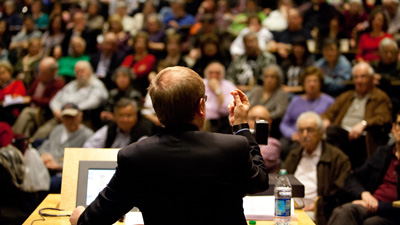By Charlene Kahn, JTNews Correspondent
Thinking about the Holocaust often comes from a Central and Eastern European focus, with recognition of the existence, established lives, and the eventual destruction of much of Sephardic Jewry further out on the periphery. Now those boundaries are expanding, thanks, in part, to a symposium at the University of Washington.
“Sephardic Jewry and the Holocaust: The Future of the Field” brought together the university’s new Sephardic Studies Initiative, the United States Holocaust Memorial Museum (USHMM) in Washington, D.C., international scholarly authorities, and Seattle’s Jewish community for two days of talks in the Allen Library April 28-30. Support also came from the Hanauer Outreach Fund of the Department of History at the University of Washington and Jack M. Karako, in memory of Rosina Karako-Smeraldi. Leah Wolfson, senior program officer in university studies at the USHMM for Advanced Holocaust Studies and symposium co-convener, said she approached the
UW with the idea for the symposium after Devin Naar was appointed assistant professor of Jewish studies and history and put in charge of the Sephardic Studies Initiative. “This symposium was also an opportunity for the Center and the Museum to engage with the Pacific Northwest,” Wolfson told JTNews. “Given the strength of the Sephardic community here and the recent appointment of Dr. Devin Naar in the Jewish Studies Program and history department at the University of Washington, Seattle was a logical choice to convene this type of an endeavor.”
The symposium was scheduled for spring 2013 to commemorate the 70th anniversary of the start of the Jewish community’s deportations from Salonika (now Thessaloniki, Greece) to Auschwitz. Eighty percent of the community perished.
Enthusiastic public support greeted the symposium. Sunday night’s keynote lecture, given by Stanford professor of Jewish history and culture Aron Rodrigue, sold out. Rodrigue’s talk, “Sephardim, Memory and the Holocaust” delved into the constructed memory of life on the Island of Rhodes among the remnant of the Rhodes Jewish community, of which 151 of about 2,000 people survived.
Recounting the history and travails of Jews from Rhodes, Rodrigue praised “the memory of Rhodes Jewry and how it lives in a diasporic space.” Rhodes Jews immigrated to Africa, North America, Latin America and Europe, settling into new communities, but they always retained their connection to their “chico Yerushalayim,” their little Jerusalem, said Rodrigue.
A local Rhodesli, retired Seattle pediatrician Sam Tarica, was moved by the lecture. “My uncle Jacob survived with my father’s help and ended up in the Belgian Congo. My father and mother escaped the Nazis, but all of our relatives [except for Jacob] were lost. It was so distressing to know they had the longest and farthest deportation of any group,” he said.
Regarding the symposium’s purpose — shedding light on the Sephardic Holocaust experience and parsing out the future of the field — Naar said, “I think that it is crucial to emphasize that not only did we attempt to find a place for the varied experiences of Sephardic and North African Jews within the standard narratives of the Holocaust, but more importantly, we initiated a discussion about how the very nature of our understandings of the Holocaust change when viewed from the Mediterranean. “With the added dimension of European colonialism, the North African cases broaden the standard geographical scope of the Holocaust considerably, and introduce questions about Muslim majority contexts,” Naar continued. “Together with the experiences of Jews in the Balkans and Greece, we can begin to develop a previously unexplored Mediterranean lens through which to view experiences of occupation, dispossession, persecution, resistance, and extermination that enrich and also challenge the more familiar narratives focused on Eastern Europe.”
The enhanced learning offered by the symposium offered an extended benefit for local organizations. “The symposium offered the Holocaust Center a wonderful opportunity to learn about the latest research in the area of Sephardic studies, allowing us to share that knowledge and perspective with educators and students throughout the Pacific Northwest,” said Dee Simon, executive director of the Washington State Holocaust Education Resource Center.
At the end of the symposium, University of California at Irvine professor of history Marc Baer reiterated this idea of dissemination and education. “We also need to consider our audience,” he said. “While we have a built-in audience of Sephardic Jews because this is their history, we should address ourselves to a wider audience, because the stories we are telling have great significance for others, too. In all of our research, the question of what it means to be a Sephardic
Jew also challenges what it means to be French, Spanish, German, Greek, or Turkish, and demonstrates how national identity changes over time.”
